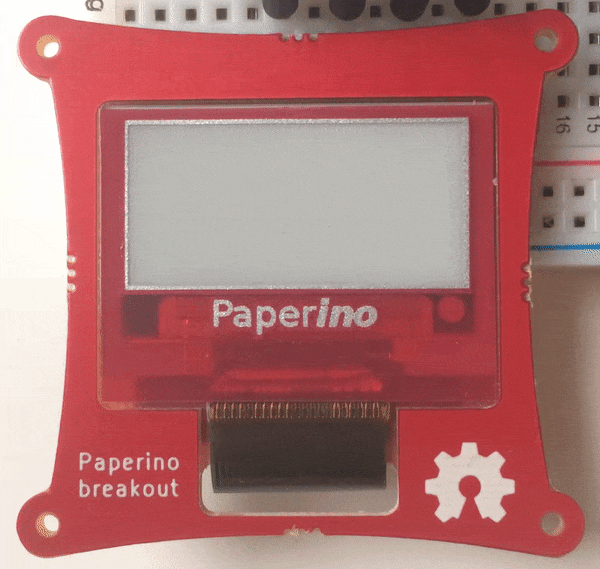Example 2: GFX Graphics demo
In the previous example we learned how to initialise the ePaper screen and write “Hello World!” on it. Now let’s try some more complicated features! In this chapter we will learn how to change the size and the position of the text and how to change the text font. Afterwards we will see how easy it is to draw some graphic elements on the display. The last section contains the sketch for an executable demo to try out by yourself.
Characters and Text
The Adafruit GFX Graphics library provides many easy to use functions to write characters and text on the screen. Typical functions are: drawChar(), setCursor(), setTextColor(), setTextSize(), setFont(), setTextWrap(). A good starting point for more detailed syntax and information is this learning site.
Graphics
For drawing graphics like circles, rectangles or triangles, the GFX library provides this typical functions: drawPixel(), drawLine(), drawRect(), fillRect(), drawCircle(), fillCircle(), drawRoundRect(), fillRoundRect(), drawTriangle(), drawfillTriangle(). Again, please head over to Adafruits learning site for more information.
Demo

Sketch
The following sketch starts with a loop which draws a sequence of ASCII characters on the screen using the function drawChar(). The next section shows how to set the font size based on the function setTextSize(). Inverting of the screen content can be done with invert(). The last part of the sketch shows how to draw some rectangles, filled rectangles and circles.
#include "Adafruit_GFX.h"
#include "PL_microEPD.h"
#define EPD_RST A0
#define EPD_BUSY A1
#define EPD_CS A2
PL_microEPD display(EPD_CS, EPD_RST, EPD_BUSY);
int i=0;
void setup() {
SPI.begin(); // SPI initialisation
SPI.setBitOrder(MSBFIRST);
SPI.setDataMode(SPI_MODE0);
SPI.setClockDivider(SPI_CLOCK_DIV4);
display.begin(); // Paperino ePaper initialisation and refresh screen
for (int y=0; y < 6; y++) {
for (int x=0; x < 26; x++) {
i=i+1; // Draw some ASCII characters
display.drawChar(1+x*7,1+y*11,i,0,3,1);
}
}
display.update(); // Trigger a full image update
delay(5000);
display.clear(); // Clear the image buffer
display.setCursor(1,1); // Set Cursor start position
display.println("Size1");
display.setTextSize(2); // Change text size
display.println("Size2");
display.setTextSize(3);
display.println("Size3");
display.setCursor(100,5);
display.setTextSize(9);
display.println("9");
display.update(); // Trigger a full image update
delay(5000);
display.invert(); // Invert the display content
display.update();
delay(5000);
display.clear();
display.drawRect(5, 5, 50, 50, EPD_BLACK); // Draw a rectangle
display.fillRect(40,40,25,25, EPD_BLACK); // Draw a filled rectangle
display.drawCircle(100, 35, 30, EPD_BLACK); // Draw a circle
display.drawCircle(100, 35, 15, EPD_BLACK);
display.drawCircle(100, 35, 8, EPD_BLACK);
display.drawCircle(100, 35, 4, EPD_BLACK);
display.update();
delay(5000);
display.clear();
display.setTextSize(2);
display.setCursor(5, 20);
display.println("Hello");
display.setCursor(5, 36);
display.println("World!");
display.drawCircle(170, 36, 40, EPD_BLACK);
display.drawCircle(170, 36, 45, EPD_BLACK);
display.drawCircle(170, 36, 50, EPD_BLACK);
display.drawCircle(170, 36, 55, EPD_BLACK);
display.drawCircle(170, 36, 70, EPD_BLACK);
display.drawCircle(170, 36, 75, EPD_BLACK);
display.drawCircle(0, 36, 135, EPD_BLACK);
display.drawCircle(0, 36, 120, EPD_BLACK);
display.drawCircle(0, 36, 75, EPD_BLACK);
display.invert();
display.update();
}
void loop() {
}
So far we used black as primary color for drawing the graphic elements. The next example will show you how to change the color and how to add the intermediate colours lightgray and darkgray. Interested? Then let’s proceed here.